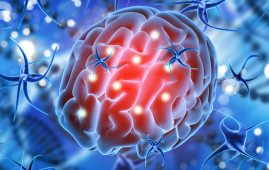

According to recent research by experts at St. Jude Children’s Research Hospital, it may be able to improve the seasonal flu vaccine and public health professionals’ capacity to identify emerging flu strains with the potential to cause a pandemic. The viral protein that enters human cells must be stable in order to function. The results were released in Science Advances today.
“We found that the protein flu viruses use to enter cells, hemagglutinin, needs to be relatively stable and resistant to acid in an effective H3N2 flu vaccine,” said senior and co-corresponding author Charles Russell, Ph.D., St. Jude Department of Infectious Diseases. “We found a mutation in hemagglutinin that makes the virus grow better in eggs also causes a mismatch in the vaccine. The mutation makes the virus unstable and makes it look less human-like.”
One of the agents responsible for seasonal flu is the H3N2 virus, which is a subtype of influenza A. The virus is grown in chicken eggs for the majority of seasonal flu vaccine production, although the virus may mutate in the process. Some of those modifications, like the one the St. Jude team discovered, reduce the vaccine’s capacity to induce the desired immunological response. Other mutations, however, have more positive effects.
“We also found a different mutation in egg adaptation that doesn’t destabilize the hemagglutinin or make it less human-like,” Russell said. “That mutation prevented the emergence of the destabilizing mutant. Going forward, incorporating this protective mutation or otherwise assuring hemagglutinin stability may help maintain vaccine efficacy.”
While scientists presently do not take viral protein stability into account when evaluating flu strains to include in the annual vaccine, egg-adaptive mutations are a well-known problem in many existing flu vaccine pipelines. Incorporating only flu strains with better levels of stability after analyzing their hemagglutinin for antigenic similarity to circulating viruses may improve the vaccine by avoiding the inclusion of strains with unstable proteins, according to this study.
The researchers discovered that it was possible to quantify hemagglutinin stability in order to more accurately predict the pandemic potential of emerging flu strains. According to a model developed to predict potential characteristics in people, flu viruses with unstable protein could not spread through the air between ferrets. Viruses with the more durable protein variant also demonstrated a high rate of airborne transmission.
“The top of the lungs and nose, called the upper respiratory tract, is mildly acidic,” Russell said. “The viral protein needs to be able to resist mild acid when it’s outside of the cell in the respiratory tract. That’s why the stable hemagglutinin improves transmission.”
When sufficiently acidic, hemagglutinin is like a mousetrap, poised to snap and prick into a human cell. The virus cannot infect any cells if unstable proteins are set off too early in the somewhat acidic lung environment.
But the virus may also have issues if the viral protein is overly stable. Previous studies demonstrated that excessive stability hinders the virus’s ability to infect fresh cells. A pandemic flu virus needs to be stable enough to survive in the mildly acidic lung environment yet unstable enough to infect quickly when it reaches the right portion of cells, according to research from the St. Jude group.
The World Health Organization (WHO) and the Centers for Disease Control (CDC) both keep an eye out for potential pandemic flu viruses globally. They are currently on the lookout for well-known changes, such as those that alter the receptors to which hemagglutinin can bind, that transform an avian flu virus into one that can infect people. This study contributes to the collection of research describing the additional alterations required for an avian virus to infect humans.
“In addition to changes in receptor binding, there are a few other properties that we now have to change too, and they’re not currently well accounted for in risk assessment, due to a lack of feasibility. But for hemagglutinin stability, it’s a simple concept to expose it to different acidities and measure the remaining infectivity of a virus,” said Russell.
The study’s findings thus imply that by including a straightforward experiment to test hemagglutinin stability, scientists may be able to more accurately determine the danger of a pandemic for novel influenza viruses.
Meng Hu, a researcher at St. Jude Children’s Research Hospital, is the study’s primary author, and Richard Webby is its co-corresponding author. The other authors are Lei Li from Weill Cornell Medicine, Shaohua Lei from St. Jude, Balaji Banoth, Chet Raj Ojha, Jeremy Jones, and Christina Kackos from St. Jude.
more recommended stories
 Neurodegeneration Linked to Fibrin in Brain Injury
Neurodegeneration Linked to Fibrin in Brain InjuryThe health results for the approximately.
 DELiVR: Advancing Brain Cell Mapping with AI and VR
DELiVR: Advancing Brain Cell Mapping with AI and VRDELiVR is a novel AI-based method.
 Retinal Neurodegeneration in Parkinson’s Disease
Retinal Neurodegeneration in Parkinson’s DiseaseBy measuring the thickness of the.
 Epilepsy Seizures: Role of Astrocytes in Neural Hyperactivity
Epilepsy Seizures: Role of Astrocytes in Neural HyperactivityRoughly 1% of people experience epilepsy.
 Role of Engineered Peptides in Cancer Immunotherapy
Role of Engineered Peptides in Cancer ImmunotherapyIn a recent publication in Nature.
 CRISPR-Cas9 Gene Therapy for Prostate Cancer
CRISPR-Cas9 Gene Therapy for Prostate CancerIn their preclinical model, the researchers.
 Epilepsy Surgery: Rare Hemorrhagic Complications Study
Epilepsy Surgery: Rare Hemorrhagic Complications StudyFollowing cranial Epilepsy Surgery, hemorrhagic complications.
 Pediatric Epilepsy – Mental Health Interventions Unveiled
Pediatric Epilepsy – Mental Health Interventions UnveiledMental health challenges frequently manifest in.
 Neoadjuvant Chemotherapy Boosts Ovarian Cancer
Neoadjuvant Chemotherapy Boosts Ovarian CancerDuring the COVID-19 pandemic, US women.
 Brain Connectivity Unveils New Insights into Autism
Brain Connectivity Unveils New Insights into AutismBecause autism spectrum disease symptoms can.

Leave a Comment